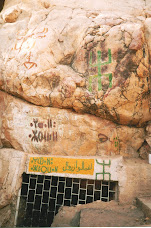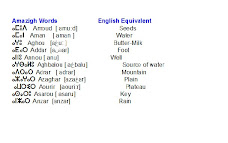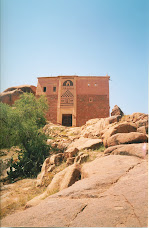Tuesday, March 25, 2008
Religion and Social Change: Islamization of the Berbers.
The evolution of Religion among The Berbers during antiquity through modern time is relevant to understand North African Culture. How religious values change and/or reshape. Modern rituals that were based on antiquity beliefs. Why Islam as a religion is different in North Africa comparing to Middle East? Magic beliefs among Berbers and other religious values. I will try to find answers to those questions.
I. Theorical Perspective:
Why should sociologists study religion or religious systems? Religion is linked to society as it maintains values and tradition. According to Sonia Roccas (2005) religious people attributed high importance to the values .Religion is one of the socialization institutions that balanced society by enforcing values and good morales.
I will borrow from Emile Durkheim the concept of “the sacred” which can be widely applied to different religious practice including honoring the death which is one the old religious practice preserved in North Africa , where old people still celebrate feasts around marabous .In the next section I will tackle some of the old beliefs during antiquity.
II. The antiquity and old beliefs:
Oric Bates (1914) divided the emergence of religion in North Africa into three important stages: the animistic phase, second the eschatology and third theology. According to the same author “The most primitive religious beliefs of the eastern Libyans were of the simple animistic sort common to all people in an advanced stage of development.” P172
North Africa is full of beliefs related to spiritual forces like hills, springs, wells and storms and winds. As we will see some of those beliefs, still remain under the same principle but in different forms. North Africa had been a crossroad for different cultures and a meeting point of eastern and western cultures since the down of history. According to Mohamed Chafiq, North Africa has been invaded by many nations (Phoenicians, Romans, Byzants, Vandales and Arabs).In addition to European invasion during last century.
Imazighen had different beliefs through history , they both respected different gods Like “ Akouch” and “Amon”.Some animals have a divine status “ ram , cow and the goat” Engraved icons of those animal are anthropological evidence found through the Great Sahara. . Berber used to honor Ammon as their god and his temple was located in the oasis Siwa (Western part of Egypt). The word “amun” [Read as Amon] is related to Berber word of “Aman” [Read as Aman] which was used to mean the lord and servant at the same time among Berbers of Canary Island. The same word used in all Amazigh varieties to mean “water” .This association is related to the old belief of giving divine values to sun and
water which lead to fertility of the land. Among the Berber community today in Morocco, a ritual is celebrated called “Talaghanja” where women go to the source of the water or the river dam called “Ugåug”[Read as Uggug] to request water during dry years. The rainbow is called among Berbers in North Africa “The bride of Heavens”. Which make the rain heavenly which another belief still has some traces within the culture today.
III. Christianity and Judaism in North Africa.
According to Mohamed Chafiq, The appearance of Christianity, the Romans were pagans but The Berbers were isolated in their religious values. The Roman government of that time gives orders to their law enforcement to kill anybody who becomes Christian. In 313 B.C, the emperor Constantinus I accepted Christianity .He made Christianity the religion of the state. The Berbers did not agree with the main church and created a new religious movement under the leadership of Donatus. This movement outreach Christianity in the rural areas. What we learn here is that human being do not like change .This is the reason why The Berbers refused religion dictated by others.
IV .The Arab Conquest and Islamization:
Islam was born in Mecca (Saudi Arabia) and spread through Persia and North Africa and from Africa through sub-Saharan Africa through Andalucía (Current Spain).This task was not easy since the Berbers were organized in military and cultural résistance. One of the famous resistances was lead by a princess called “Tihiya”.This military resistance delayed invasion of North Africa. As it is mentioned some of the old beliefs were reshaped to go in harmony with Islam, for instance Imazighen beliefs in supernatural forces and spirits related to the lakes and water, Islam brought “Jins” as another creation beside human beings. I still remember as a small kid, people used to scare children about existence of “The goat of the Mosque” or “the goat of the well” which is bad spirit. I think the old belief was “the goat of the well” then later with islamization of
Berbers in North Africa, the same goat becomes the goat of the mosque related to the mosque.
To sum up, understanding old beliefs and the history of religion in North Africa is a key element to understand current political, social structure of the Berbers through history. The study of religions in general, is an urgency to spread understanding of various beliefs that will teach values of peace, tolerance and acceptance to the new generations. Which will lead interfaith dialogues.
References:
Bates, O. (1914). Eastern Libyans: An Essay. McMillan and Co.Ltd. London.
Durkheim, E. (1924). Sociologie et Philosophie [Book written in
French].Librairie Felix Alcan. Paris.
Roccas, S. (2005). Religion and Value Systems. Journal of Social Issues, Vol 61, No 4, pp747-759.
Shafiq, M. (1990). Thirty –three centuries of Imazighen History [book written in Arabic] .Tawalt Cultural Foundation.
Tawalt Cultural Foundation: www.tawalt.com
Agraw Amazigh Newspaper.
The evolution of Religion among The Berbers during antiquity through modern time is relevant to understand North African Culture. How religious values change and/or reshape. Modern rituals that were based on antiquity beliefs. Why Islam as a religion is different in North Africa comparing to Middle East? Magic beliefs among Berbers and other religious values. I will try to find answers to those questions.
I. Theorical Perspective:
Why should sociologists study religion or religious systems? Religion is linked to society as it maintains values and tradition. According to Sonia Roccas (2005) religious people attributed high importance to the values .Religion is one of the socialization institutions that balanced society by enforcing values and good morales.
I will borrow from Emile Durkheim the concept of “the sacred” which can be widely applied to different religious practice including honoring the death which is one the old religious practice preserved in North Africa , where old people still celebrate feasts around marabous .In the next section I will tackle some of the old beliefs during antiquity.
II. The antiquity and old beliefs:
Oric Bates (1914) divided the emergence of religion in North Africa into three important stages: the animistic phase, second the eschatology and third theology. According to the same author “The most primitive religious beliefs of the eastern Libyans were of the simple animistic sort common to all people in an advanced stage of development.” P172
North Africa is full of beliefs related to spiritual forces like hills, springs, wells and storms and winds. As we will see some of those beliefs, still remain under the same principle but in different forms. North Africa had been a crossroad for different cultures and a meeting point of eastern and western cultures since the down of history. According to Mohamed Chafiq, North Africa has been invaded by many nations (Phoenicians, Romans, Byzants, Vandales and Arabs).In addition to European invasion during last century.
Imazighen had different beliefs through history , they both respected different gods Like “ Akouch” and “Amon”.Some animals have a divine status “ ram , cow and the goat” Engraved icons of those animal are anthropological evidence found through the Great Sahara. . Berber used to honor Ammon as their god and his temple was located in the oasis Siwa (Western part of Egypt). The word “amun” [Read as Amon] is related to Berber word of “Aman” [Read as Aman] which was used to mean the lord and servant at the same time among Berbers of Canary Island. The same word used in all Amazigh varieties to mean “water” .This association is related to the old belief of giving divine values to sun and
water which lead to fertility of the land. Among the Berber community today in Morocco, a ritual is celebrated called “Talaghanja” where women go to the source of the water or the river dam called “Ugåug”[Read as Uggug] to request water during dry years. The rainbow is called among Berbers in North Africa “The bride of Heavens”. Which make the rain heavenly which another belief still has some traces within the culture today.
III. Christianity and Judaism in North Africa.
According to Mohamed Chafiq, The appearance of Christianity, the Romans were pagans but The Berbers were isolated in their religious values. The Roman government of that time gives orders to their law enforcement to kill anybody who becomes Christian. In 313 B.C, the emperor Constantinus I accepted Christianity .He made Christianity the religion of the state. The Berbers did not agree with the main church and created a new religious movement under the leadership of Donatus. This movement outreach Christianity in the rural areas. What we learn here is that human being do not like change .This is the reason why The Berbers refused religion dictated by others.
IV .The Arab Conquest and Islamization:
Islam was born in Mecca (Saudi Arabia) and spread through Persia and North Africa and from Africa through sub-Saharan Africa through Andalucía (Current Spain).This task was not easy since the Berbers were organized in military and cultural résistance. One of the famous resistances was lead by a princess called “Tihiya”.This military resistance delayed invasion of North Africa. As it is mentioned some of the old beliefs were reshaped to go in harmony with Islam, for instance Imazighen beliefs in supernatural forces and spirits related to the lakes and water, Islam brought “Jins” as another creation beside human beings. I still remember as a small kid, people used to scare children about existence of “The goat of the Mosque” or “the goat of the well” which is bad spirit. I think the old belief was “the goat of the well” then later with islamization of
Berbers in North Africa, the same goat becomes the goat of the mosque related to the mosque.
To sum up, understanding old beliefs and the history of religion in North Africa is a key element to understand current political, social structure of the Berbers through history. The study of religions in general, is an urgency to spread understanding of various beliefs that will teach values of peace, tolerance and acceptance to the new generations. Which will lead interfaith dialogues.
References:
Bates, O. (1914). Eastern Libyans: An Essay. McMillan and Co.Ltd. London.
Durkheim, E. (1924). Sociologie et Philosophie [Book written in
French].Librairie Felix Alcan. Paris.
Roccas, S. (2005). Religion and Value Systems. Journal of Social Issues, Vol 61, No 4, pp747-759.
Shafiq, M. (1990). Thirty –three centuries of Imazighen History [book written in Arabic] .Tawalt Cultural Foundation.
Tawalt Cultural Foundation: www.tawalt.com
Agraw Amazigh Newspaper.
Subscribe to:
Post Comments (Atom)

Copyright (c) 2007-2008
Amazigh Virtual Museum
USA
boussaidb@bellsouth.net
Brahim Boussaid
Project Manager
Amazigh Virtual Museum
USA
boussaidb@bellsouth.net
Brahim Boussaid
Project Manager










No comments:
Post a Comment